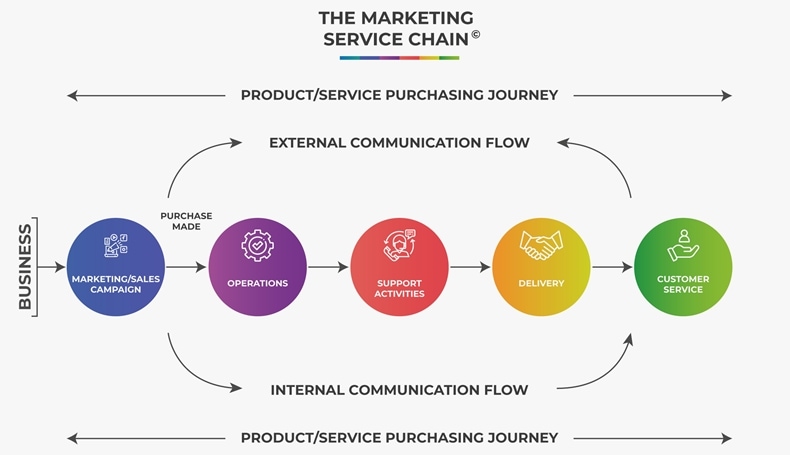A brand is made up of many elements: strategy, target market, customers, advertising, marketing, innovation, and many more.
However, one element seems to get left behind: the staff. The employees. The back-end operations that support the brand.
The dedication and expertise of the people within a company help create the brand as we know it. Yet, those people are often overlooked, which can cause damage to the company image in the market.
Look at the people behind the scenes, and ensure departments are in harmony and are working together to achieve the same goal. By doing so, you not only strengthen your brand but also optimize the customer's overall experience.
What is the Marketing Service Chain?
The Marketing Service Chain consists of the links of communication that takes place from the initial marketing campaign to the purchase to the customer's receiving their order. It analyzes both paths of communication: from the company to the customer, and within the company itself.
The aim of the Marketing Service Chain is to optimize the customer experience by eliminating communication breakdowns or flaws on either path. It is an excellent tool for creating a smooth flow within your organization, and it puts you into an optimal position for your marketing campaigns.
Your employees and their productivity contribute to the strength of your brand. It is vital that a company understand the importance of creating synergy across all departments. An excellent marketing strategy has no point if you are not delivering on your promises.
For example, if an office furniture company has positioned itself in the market as offering prompt delivery and excellent customer service, it must live up to that promise. Let's say that for the past couple of months, lots of deliveries have been late and customers are complaining about not being able to speak to someone in customer service because of unanswered calls.
Let's also say that Marketing then decides to run a campaign about the company's strengths and reasons people should buy from the company. What will happen?
The company's social media platforms will be flooded with complaints, and its brand will be damaged immensely. People may lose trust in the brand, and repairing trust is difficult.
That's where the Marketing Service Chain can help you. I created this model after identifying a gap in how companies believe they are perceived in the market compared with how they are perceived.
How to Improve Customer Experience With the Marketing Service Chain
By using the Marketing Service Chain, you can iron out flaws in your communication processes, both internal and external, and therefore bridge the gap between what you promise and what you deliver.

Marketing or Sales Campaign
External communication: What messaging did the market receive? What promises are the sales team making?
Internal communication: Has that messaging been communicated within the company so every employee is in every department is aware of it?
It's important to include all departments in communication related to your marketing campaigns. That way, if Reception, Customer Service, or Accounts are speaking to customers or potential customers, they can answer questions about the campaign.
It also shows a united front for the company and makes the employee feel more valued, which adds to the overall strength of your brand. I recommend creating a monthly or quarterly marketing campaign schedule and sharing it across departments.
Operations
External communication: What communication does the customer receive once they have placed an order?
Internal communication: What communication takes place behind the scenes once an order is made? What departments are notified? What information is shared? Are there are any steps that could be cut out to make the process quicker? Or should steps be introduced to make the process run more smoothly?
Support Activities
Internal communication: Does any communication flow out to the customer from these departments?
External communication: What departments need to be aware of the order once it has been made? How do they receive the communication? What is their role once they receive that information? Is there a way of cutting out unnecessary tasks, or is there a need to introduce new ones to streamline the process?
Delivery
External communication: What communication does the customer receive at this stage? Is it relevant, and should anything be added?
Internal communication: Where does the information come from, and does it include all the relevant information needed for the department to complete the order? Is there any room to remove necessary steps? Is there a need to introduce additional steps? What communication is needed when tasks are complete?
Customer Service
External communication: Is there any follow-up communication to the customer post-delivery?
Internal communication: What communication has Customer Service received from within the company about orders? Do they have to request additional information if an issue arises, or is information readily available? Is there a smooth process that follows for dealing with returns, refunds, unhappy customers, etc.?
* * *
If you take the time to analyze your Marketing Service Chain closely, it will help you streamline the communication flow within your company—which can also present opportunities that you may not have seen before.
And, most important, improving the Marketing Service Chain will greatly improve the customer experience, thereby strengthening your brand and helping you increase your marketing budget.
More Resources on How to Improve Customer Experience
Customer Experience Management Isn't Enough: Three Steps to Experience Improvement
MarketingProfs Customer Experience (CX) Guide
How to Use Voice of the Customer in B2B to Improve CX and Increase Engagement




